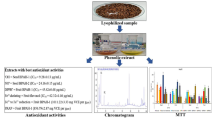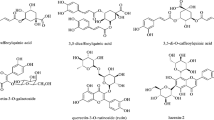Abstract
Methanol extracts of 4 different colored (red, orange, yellow, and green) bell peppers (Capsicum annuum L.) were examined to (1) determine the total phenolic content (TPC), (2) compare the antioxidant activities, (3) assess the protective effects of extracts on H2O2-induced and 4-hydroxy-2-nonenal (HNE)-induced DNA damage using the Comet assay, and (4) examine the antiproliferative action of their extracts on HT-29 cells. Red and orange bell peppers had significantly higher levels of TPC than yellow or green bell peppers. Orange bell pepper exhibited the highest level of radical scavenging activity and total antioxidant activity, while green bell pepper exhibited the highest superoxide dismutase-like activity. These results suggest that the difference in antioxidant activities may depend on the kinds of antioxidant compounds related to the color of the pepper. It was found a significant negative correlation between TPC and radical scavenging activity inhibiting capacity (IC)50, and a significant positive corretation between TPC and total antioxidant activity. All extracts of bell pepper inhibited H2O2-induced and 4-hydroxy-2-nonenal-induced DNA damage in human leukocytes and showed potential toxicity on HT-29 cells. These findings suggest that the 4 different colored bell peppers may be useful as antioxidants and cancer prevention in food.
Similar content being viewed by others
References
Singh RP, Murthy KNC, Jayaprakasha GK. Studies on the antioxidant activity of pomegranate (Punica granatum) peel and seed extracts using in vitro models. J. Agr. Food Chem. 50: 81–86 (2002)
Kaur C, Kapoor HC. Antioxidants in fruits and vegetables-the millennium’s health. Inter. J. Food. Sci. Technol. 36: 703–725 (2001)
Martínez-Tomé M, Jiménez AN, Ruggieri S, Frega N, Strabbioli R, Murcia MA. Antioxidant properties of mediterrancan spices compared with common food additives. J. Food Protect. 64: 1412–1419 (2001)
Wang H, Cao G, Prior RL. Total antioxidant capacity of fruits. J. Agr. Food Chem. 44: 701–705 (1996)
Velioglu YS, Mazza G, Gao L, Oomah BD. Antioxidant activity and total phenolics in selected fruits, vegetables, and grain products. J. Agr. Food Chem. 46: 4113–4117 (1998)
Seppanen CM, Csallany AS. The effect of paprika carotenoids on in vivo lipid peroxidation measured by urinary excretion of secondary oxidation products. Nutr. Res. 22: 1055–1065 (2002)
Lightbourn GJ, Griesbach RJ, Novotny JA, Clevidence BA, Rao DD, Stommel JR. Effects of anthocyanin and carotenoid combinations on foliage and immature fruit color of Capsicum annuum L. J. Hered. 99: 105–111 (2008)
Zhang D, Hamauzu Y. Phenolic compounds, ascorbic acid, carotenoids, and antioxidant properties of green, red, and yellow bell peppers. J. Food Agric. Environ. 1: 22–27 (2003)
Sun T, Xu Z, Wu CT, Janes M, Prinyawiwatkul W, No HK. Antioxidant activities of different colored sweet bell peppers (Capsicum annuum L.). J. Food Sci. 72: S98–S102 (2007)
Simonne AH, Simmone EH, Eitenmiller RR, Mills HA, Green NR. Ascorbic acid and provitamin A contents in unusually colored bell peppers (Capsicum annuum L.). J. Food Compos. Anal. 10: 299–311 (1997)
Chuah AM, Lee YC, Yamaguchi T, Takamura H, Yin LJ, Matoba T. Effect of cooking on the antioxidant properties of coloured peppers. Food Chem. 111: 20–28 (2008)
Duthie SJ, Collins AR, Duthie GG, Dobson VL. Quercetin and myricetin protect against hydrogen peroxideinduced DNA damage (strand breaks and oxidised pyrimidines) in human lymphocytes. Mutat. Res. 393: 223–231 (1997)
Anderson D, Yu TW, Phillips BJ, Schemetzen P. The effects of various antioxidants and other modifying agents on oxygen-radicalgenerated DNA damage in human lymphocytes in the comet assay. Mutat Res. 307: 261–271 (1994)
Betancourt M, Oritz R, Gonzaliz C, Perez P, Cortes L. Rodriguez L, Villasenor L. Assessment of DNA damage in leukocytes from infected and malnourished children by single cell gel electrophoresis/comet assay. Mutat Res. 331: 65–77 (1995)
Ishii T, Itoh K, Ruiz E, Leake DS, Unoki H, Yamamoto M, Mann GE. Role of Nrf2 in the regulation of CD36 and stress protein expression in murine macrophages: Activation by oxidatively modified LDL and 4-hydroxynonenal. Circ. Res. 94: 609–616 (2004)
Tjalkens RB, Cook LW, Petersen DR. Formation and export of the glutathione conjugate of 4-hydroxy-2,3-E-nonenal (4-HNE) in hepatoma cells. Arch. Biochem. Biophy. 361: 113–119 (1999)
Remacle J, Raes M, Toussaint O, Renard P, Rao G. Low levels of reactive oxygen species as modulators of cell function. Mutat Res. 316: 103–122 (1995)
Boivin D, Lamy S, Lord-Dufour S, Jackson J, Beaulieu J, Cote M, Moghrabi A, Barrette S, Gingras D, Beliveau R. Antiproliferative and antioxidant activities of common vegetables: A comparative study. Food Chem. 112: 374–380 (2009)
Lila MA. From beans to berries and beyond: Teamwork between plant chemicals for protection of optimal human health. Ann. NY Acad. Sci. 1114: 372–380 (2007)
Vainio H, Weiderpass E. Fruit and vegetables in cancer prevention. Nutr. Cancer 54: 111–142 (2006)
Rice-Evans C, Miller NJ. Total antioxidant status in plasma and body fluids. pp. 279–293 In: Methods in Enzymology. Academic Press, New York, NY, USA (1994)
Blois MS. Antioxidant determinations by the use of a stable free radical. Nature 181: 1199–1200 (1958)
Re R, Pellegrini N, Proteggente A, Pannala A, Yang M, Rice-Evans C. Antioxidant activity applying an improved ABTS radical cation decolorization assay. Free Radical Biol. Med. 26: 1231–1237 (1999)
Martinez-Villaluenga C, Zielinski H, Frias J, Piskula MK, Kozlowska H, Vidal-Valverde C. Antioxidant capacity and polyphenolic content of high-protein lupin products. Food Chem. 112: 84–88 (2009)
Niki E, Shimasaki (eds). Active Oxygen. Ishiyaku-Shuppan, Tokyo, Japan. pp. 22–40 (1987)
Nishikimi M. Oxidation of ascorbic acid with superoxide anion generated by the xanthine-xanthine oxidase system. Biochem. Bioph. Res. Co. 63: 463–468 (1975)
Goldstein IM, Kaplan HB, Edelson HS, Weissmann G, Ceruloplasmin. A scavenger of superoxide anion radicals. J. Biol. Chem. 254: 4040–4045 (1979)
Okonogi S, Duangrat C, Anuchpreeda S, Tachakittirungrod S, Chowwanapoonpohn S. Comparison of antioxidant capacities and cytotoxicities of certain fruit peel. Food Chem. 103: 839–846 (2007)
Cohen G. The Fenton reaction. pp. 55–64. In: CRC Handbook of Methods for Oxygen Radical Research. Greenwald RA (ed). CRC Press, Inc., Boca Raton, FL, USA (1985)
Blanc EM, Kelly JF, Mark, RJ, Waeg G, Mattson MP. 4-Hydroxynonenal, an aldehydic product of lipid peroxidation, impairs signal transduction associated with muscarinic acetylcholine and metabotropic glutamate receptors: Possible action on Gaq/11. J. Neurochem. 69: 570–580 (1997)
Burns J, Fraser PD, Bramley PM. Identification and quantification of carotenoids, tocopherols, and chlorophyll in commonly consumed fruits and vegetables. Phytochemistry 62: 939–947 (2003)
Haegele AD, Gillette C, O’Neill C, Wolfe P, Heimendinger J, Sedlacek S, Thompson HJ. Plasma xanthophyll carotenoids correlate inversely with indices of oxidative DNA damage and lipid peroxidation. Cancer Epidem. Biomar. 9: 421–425 (2000)
Collins AR, Olmedilla B, Southon S, Granado F, Duthie SJ. Serum carotenoids and oxidative DNA damage in human lymphocytes. Carcinogenesis 19: 2159–2162 (1998)
Maoka T, Mochida K, Kozuka M, Ito Y, Fujiwara Y, Hashimoto K, Enjo F, Ogata M, Nobukuni Y, Tokuda H, Nishino H. Cancer chemopreventive activity of carotenoids in the fruits of red paprika Capsicum annuum L. Cancer Lett. 172: 103–109 (2001)
Lowe GM, Booth LA, Young AJ, Bilton RF. Lycopene and β-carotene protect against oxidative damage in HT-29 cell at low concentrations but rapidly lose this capacity at higher doses. Free Radical Res. 30: 141–151 (1999)
Bronzetti G, Galli A, Della Croce C. Antimutagenic effects of chlorophyllin. Basic Life Sci. 52: 463–468 (1990)
Dhir H. Plant extracts as desmutagens: Some aspects. Acta Bot. Indica 17: 1–11 (1989)
Russo A, Cardile V, Lombardo L, Vanella L, Vanella A, Garbarino JA. Antioxidant activity and antiproliferative action of methanolic acid of methanolic extract of Geum quellyon sweet roots in human tumor cell lines. J. Ethnopharmacol. 100: 323–332 (2005)
Decker T, Lohmann-Matthes MA. Quick and simple method for the quantitation of lactate dehydrogenase release in measurements of cellular cytotoxicity and tumor necrosis factor (TNF) activity. J. Immunol. Methods 15: 61–69 (1988)
Fotakis G, Timbrell JA. In vitro cytotoxicity assays: Comparison of LDH, neutral red, MTT, and protein assay in hepatoma cell lines following exposure to cadmium chloride. Toxicol. Lett. 160: 171–177 (2006)
Ju EM, Lee SE, Hwang HJ, Kim JH, Antioxidant and anticancer activity of extract from Betula platyphylla var. japonica. Life Sci. 74: 1013–1026 (2004)
Magiatis P, Pratsinis H, Kalpoutzakis E, Konstantinidou A, Davaris P, Skaltsounis AL. Hydrolyzable tannins, the active constituents of three Greek Cytinus taxa against several tumor cell lines. Biol. Pharm. Bull. 24: 707–709 (2001)
Son YO, Kim J, Lim JC, Chung Y, Chung GH, Lee JC. Ripe fruit of Solanum nigrum L. inhibits cell growth and induces apoptosis in MCF-7 cells. Food Chem. Toxicol. 41: 1421–1428 (2003)
Morre DJ, Chueh P-J, Morre DM. Capsaicin inhibits preferentially the NADH oxidase and growth of transformed cells in culture. P. Natl. Acad. Sci. USA 92: 1831–1835 (1995)
Sun IL, Sun EE, Crane FL, Morre DJ, Lindgren A, Low H. Requirement for coenzyme Q in plasma membrane electron transport. P. Natl. Acad. Sci. USA 89: 11126–11130 (1992)
Macho A, Calzado MA, Munoz Blanco J, Gomez Diaz C, Gajate C, Mollinedo F, Navas P, Munoz E. Selective induction of apoptosis by capsaicin in transformed cells: The role of reactive oxygen species and calcium. Cell Death Differ. 6: 155–165 (1999)
Wolvetang EJ, Larm JA, Moutsoulas P, Lawen A. Apoptosis induced by inhibitors of the plasma-membrane NADH-oxidase involves Bcl-2 and calcineurin. Cell Growth Differ. 7: 1315–1325 (1996)
Yazawa S, Suetome N, Okamoto K, Namiki T. Content of capsaicinoids and capsaicinoid-like substances in fruit of pepper (Capsicum annum L.) hybrids made with “CH-19 sweet” as a parent. J. Jpn. Soc. Hortic. Sci. 58: 601–607 (1989)
Author information
Authors and Affiliations
Corresponding author
Rights and permissions
About this article
Cite this article
Park, JH., Jeon, GI., Kim, JM. et al. Antioxidant activity and antiproliferative action of methanol extracts of 4 different colored bell peppers (Capsicum annuum l.). Food Sci Biotechnol 21, 543–550 (2012). https://doi.org/10.1007/s10068-012-0069-2
Received:
Revised:
Accepted:
Published:
Issue Date:
DOI: https://doi.org/10.1007/s10068-012-0069-2




